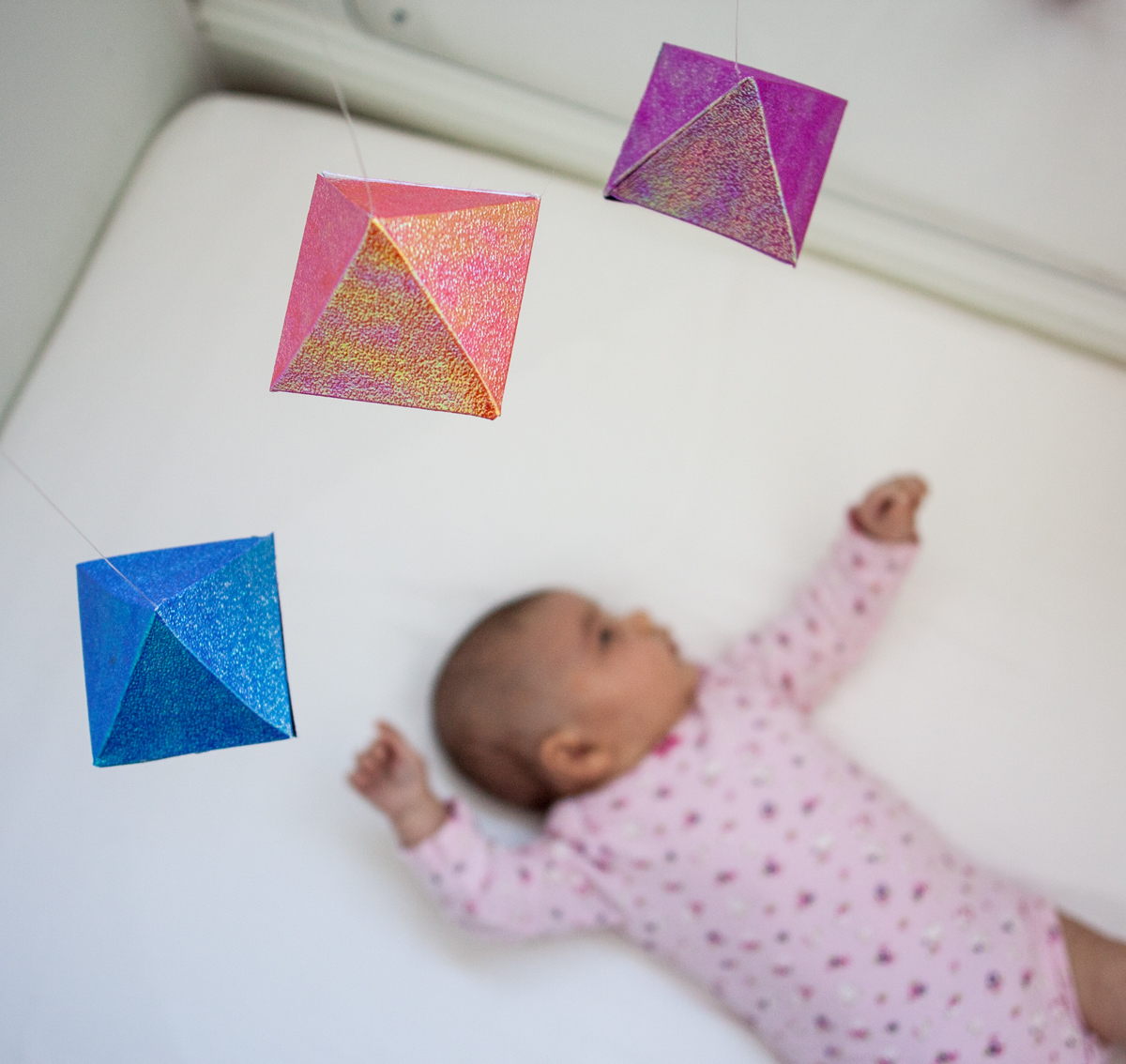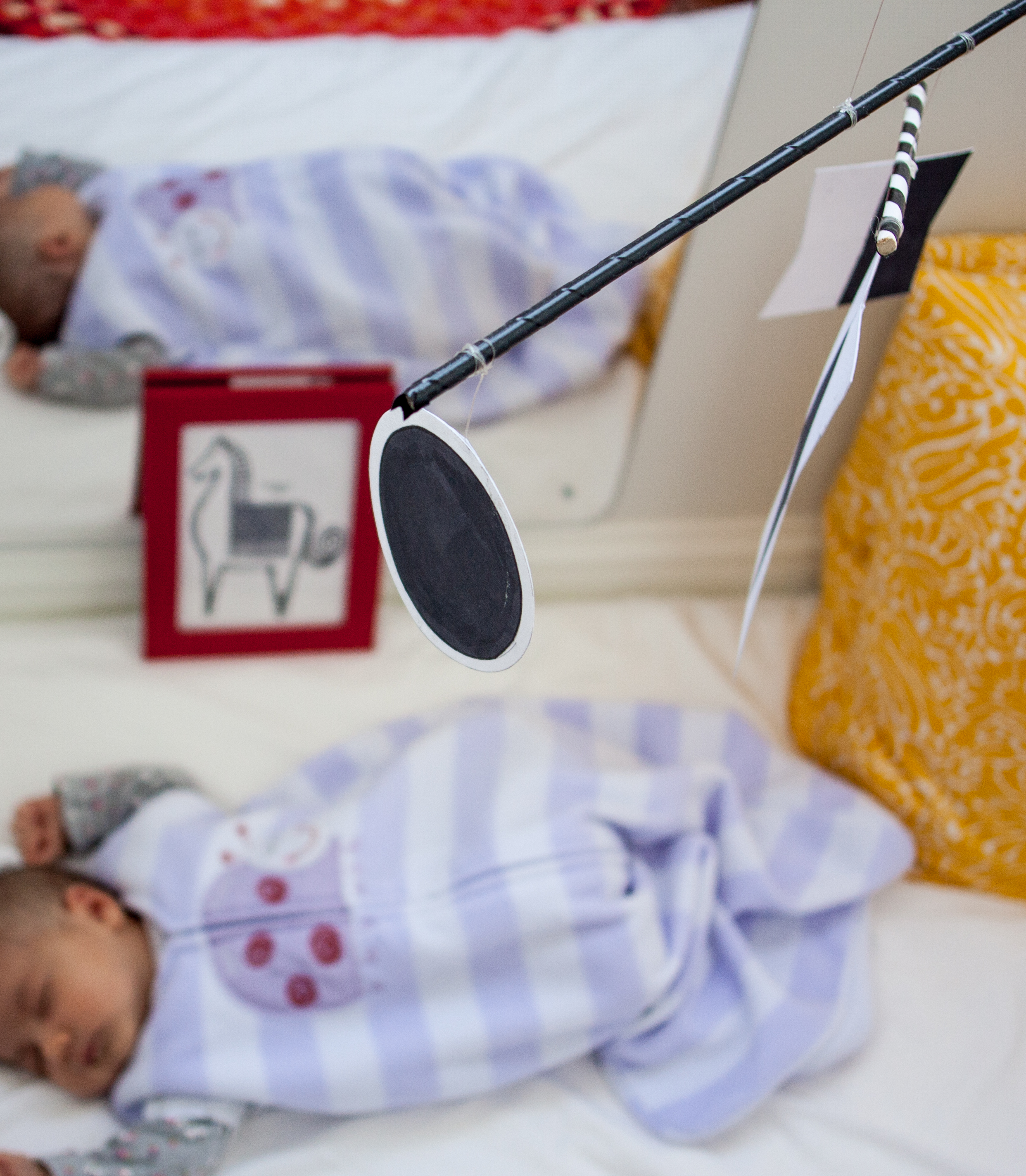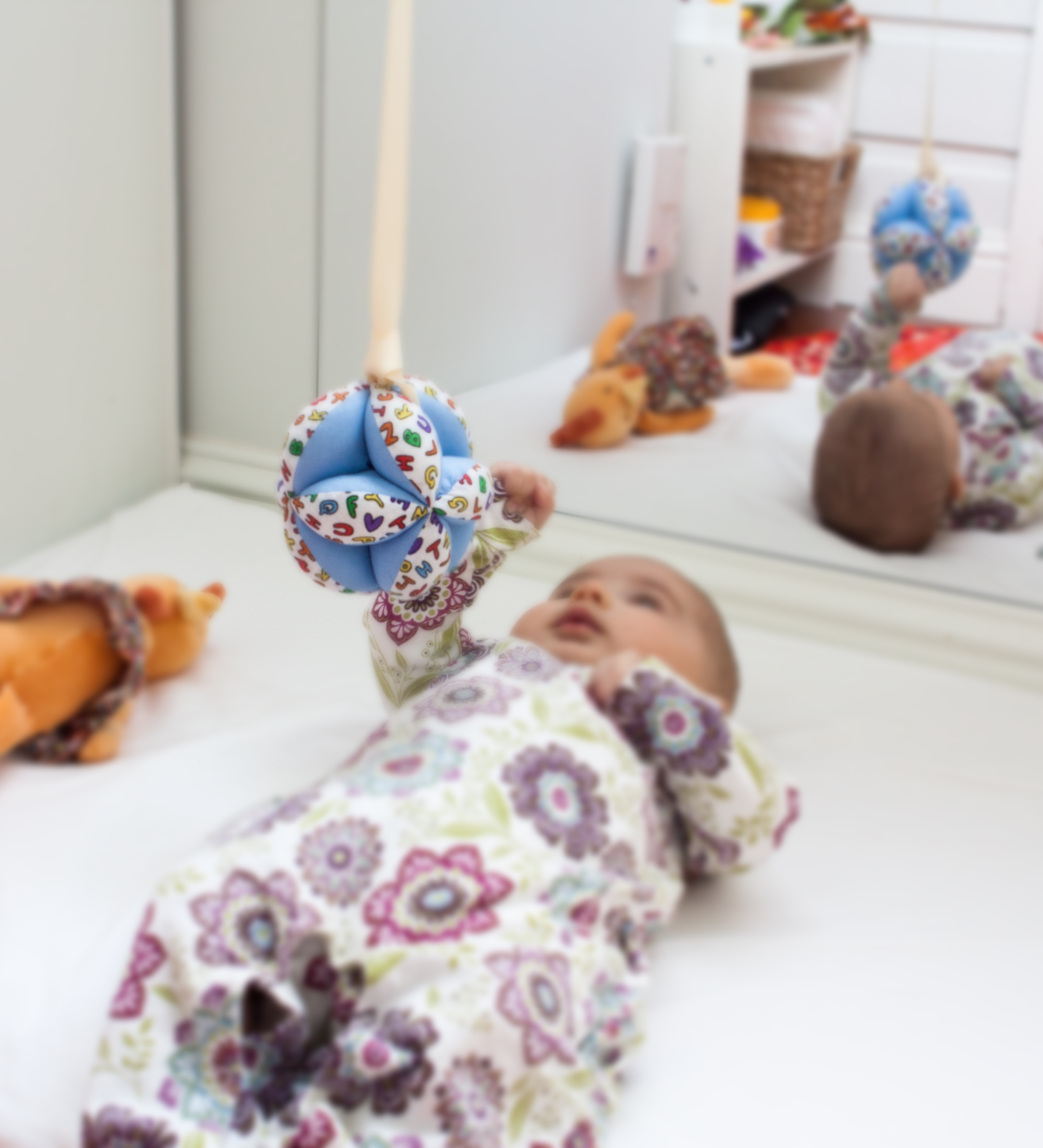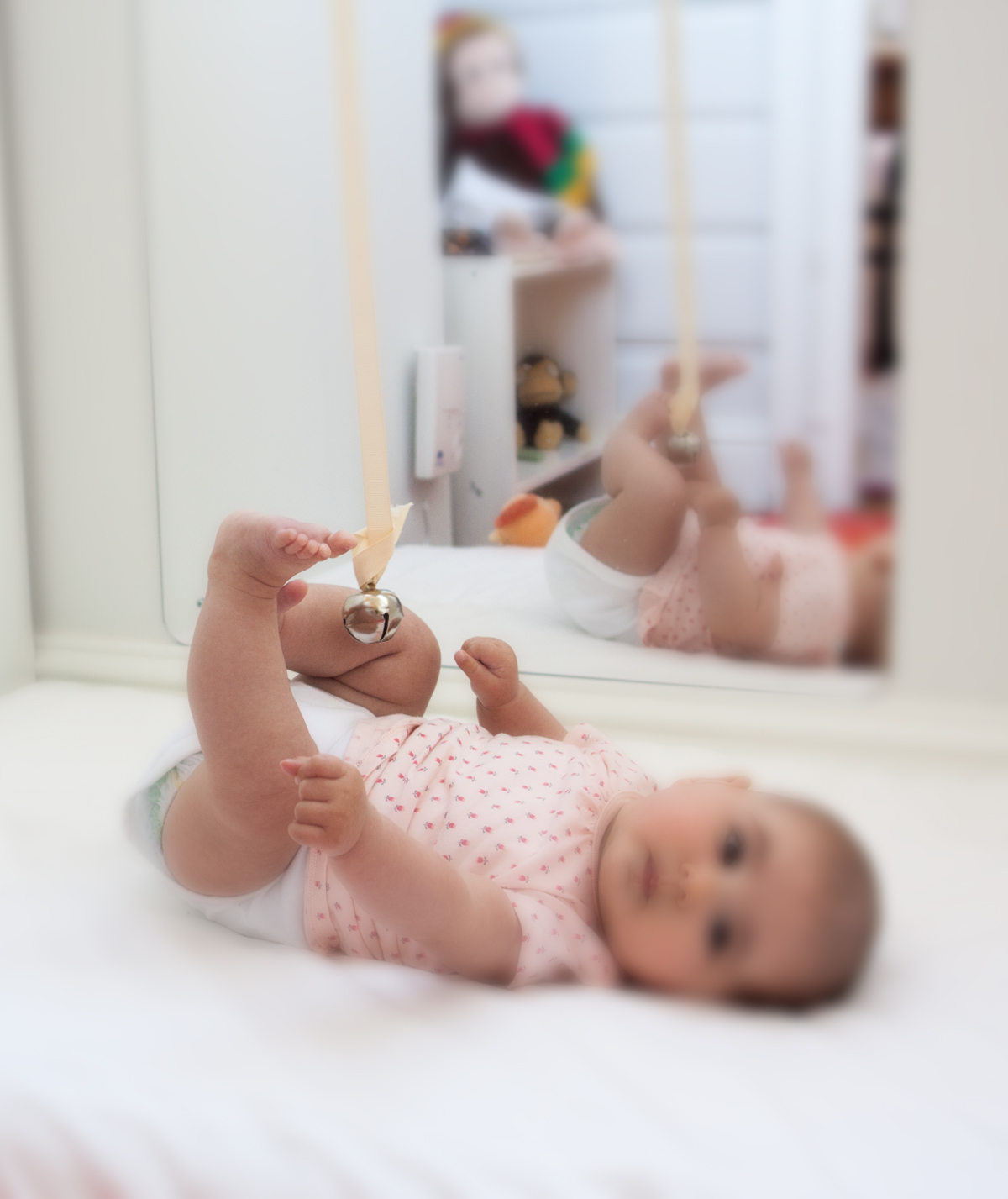One of the most fun things we did with Newborn Bean was the Montessori Mobile Progression. We had read about it in Montessori From the Start, and “from the start” rang true, as the progression begins almost as soon as the baby is born.
As Polk and Lillard write, by providing mobiles at an early age, “parents have sent a vital message: ‘We are not the only interesting things in the environment. You are going to belong to the world, not just to us.'” I loved that sentiment. Mobiles provided Newborn Bean a focus in her narrow world, something to stare at and process when she still couldn’t move her limbs or head purposefully.
The progression begins with a high contrast, black and white mobile, then moves on to introduce primary colors, then hues of the same color, followed by movement. Then, at the 12 week mark, a huge break by introducing mobiles that encourage an infant to reach out and grasp it — a ball on a ribbon, a bell on a string, and a wooden ring on an elastic cord. The progression makes sense and works congruently with an infant’s emerging abilities and interests.
For us, the mobile progression answered a few questions: what exactly do you do with a two month old? And also: when do babies start using their hands? Legs? The mobile progression was a good way to learn about infant development — understanding how far she could see at birth, when she could finally see color, when she could move her head, when she could finally move her arms and legs with intention. I had no idea about any of this. (I’d also say that knowing about infant development made her first few months much more fascinating than they otherwise might have been. I didn’t think babies could do much, but it turns out they are doing and learning SO MUCH at all times, just in their subtle baby ways.)
Here is the progression as we followed it. I’m including some of the other suggested mobiles as well, but we only used a few.
Munari Mobile (3 to 6 weeks)
The oddest of the bunch! The high contrast, black and white mobile is for small infants who still see the world in a blur. The mobile is placed 10 inches from a baby’s face, because that is about as far as infants can see. Babies also can’t position their head on the centerline yet, so by placing a mirror next to the mobile, she can look at the mobile’s reflection without turning her head.
We positioned this in Bean’s roomette while she was still sleeping in our room. We would catch her tracking it during diaper changes from even 1 week old, shockingly enough. It was amazing to see someone so young noticing something in her world.
Here is an online tutorial to make your own, but you can also buy them off Etsy. (Making your own is an exercise in geometry, patience, and learning to balance out a mobile. But, pretty easy and much cheaper than buying.)
Octahedron Mobile (5 to 8 weeks)
By far, Bean’s favorite. I put it up at 5 weeks, and was met with gleeful smiles and full body kicks and spasms. Yes, the first time I saw my baby smile was at this mobile, not at me. This mobile was so exciting for Baby Bean that I had to pull it away long before nap times or she’d be too residually excited to sleep.
In the photo, you can see she’s still using the mirror to look at her mobile. By the end of her first day with it, she was peeking at it through the corner of her eye, and she could position her head on the centerline within a week to look at it straight-on.
Here is the tutorial to make your own Octahedron Mobile, or you can also buy it off Etsy.
Gobbi Mobile (7 to 10 weeks)
This mobile was my favorite and the most beautiful. Cascading orbs of the same color in different hues. Gorgeous. Bean ran right through this mobile though, as she was becoming increasingly grabby.
Making your own is pretty difficult and materials might be hard to find. But, this also explains why they’re so expensive to buy too.
Dancers Mobile (8 to 13 weeks)
The next series of mobiles introduces realistic movement — dancers, whales, and hummingbird mobiles. The Flowing Rhythm Mobile is gorgeous but outside my skill set and price range. Bean was not too interested in the Dancers Mobile I did make, perhaps because my DIY mobile didn’t really move that well.
Grasping Ball on Ribbon (12 weeks)
This was a huge leap for Bean at 12 weeks. She went from merely looking at the world to trying to manipulate it. At first, I didn’t know if her movements hitting the ball were intentional or not (infant’s arms tend to flail randomly) but over the course of the first day, her arm movements went from looking quite random to tracking slowly to hit the ball. It was fascinating to see her learn how to move her body, right before my eyes.
You can buy the grasping ball here.
Bell on Ribbon (12 to 17 weeks)
I believe the bell on ribbon is intended to work similarly to the grasping ball — baby moves arms randomly, starts hitting something that makes a noise, and then proceeds to aim to hit it in order to repeat the noise. However, it became clear that Bean was much more interested in using her feet to hit the ball. So, this also became a lesson in “following the child.” I scooted her down so that her feet were closer to the bell.
Bean’s Montessori teacher tries to explain to us that there is no right way to use a Montessori material, as long as it is being used with intention and respect. Those of us trying to do Montessori at home sometimes get caught up in “the right way” to do stuff versus “following the child.” As she explains, children unconsciously seek out activities that will help them learn and practice new skills. Perhaps here, infant Bean unconsciously understood that she had the arm movement thing down for now and needed to work on intentional leg movements instead.
It’s no surprise that 10 days later, she could suddenly sit up. Days after that, she had learned how to slither off her floor bed and across the room, using her feet to propel her around (at only 4 months old). She was suddenly so much stronger and knew how to move her body to get what she wanted.
Wood Ring on Elastic (12 to 17 weeks)
I don’t have photos of this, because I was too busy taking video instead. Whereas Bean practiced merely touching the ball on ribbon, with her wood ring on elastic, she learned that she could not only touch something but grab it with all her might and send it flying. It was a full body sport – with spasmodic back arching, full body lunges in order to make it happen. This was a hysterical stage in her development.
We had so much fun with the Montessori mobile progression, that I’d highly recommend it to anyone. It felt like a way to connect with someone so small she couldn’t really do much, but it was also a way to learn how much she was actually doing.
—————————————————————————-
Source list: Jonti Craft Acrylic Wall Mirror and Mobile Hanger.












Anastasua
Hi! Just now seeing these Montessori mobiles and my little one is 12 weeks old 🙁 should I start with the mobiles at the 12 week mark or from the very beginning newborn on up? Will it still be beneficial if I didn’t get to do these specific mobiles with him from the beginning? :/ thanks!
1/19/2017 at 9:17 pm
Maria
It’s always worth a shot! (Well, if you’re willing to spend the money or time to make them.) You could always try an earlier one and see if he responds well. If he looks bored or uninterested, try the next one in the series.
If he’s already using his hands, or is almost there, you can probably start with the ribbon and bell or ribbon and circle. The key with Montessori is timing — you always want to hit that sweet spot of interest and ability, helping them learn a new skill.
Good luck!
1/20/2017 at 9:10 am